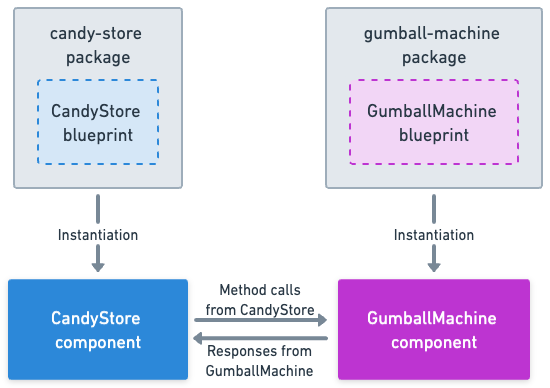With the right access, components on the Radix ledger can contact and call methods on global components instantiated from other packages. This section shows us how to make those external calls with our now very familiar Candy Store and Gumball Machine components.
External Components
There are many methods to use external components in Scrypto. Here we show you one of the simpler of these ways. There are two main steps:
First, we use the extern_blueprint! macro to import the external blueprint into our own. This process is the same as in the previous section, but this time we won't instantiate the external component in our package.
extern_blueprint! {
// import the GumballMachine package from the ledger using its package address
"<YOUR_GUMBALL_MACHINE_PACKAGE_ADDRESS>",
GumballMachine {
// --snip--
}
}
Second, we store the external component's address (and owner badge for non public method calls) in our in our new component's state.
struct CandyStore {
gumball_machine_owner_badge: Vault,
gumball_machine_address: Global<GumballMachine>,
}
The important part here is the address is stored as the component's type, Global<GumballMachine>. Component types are all addresses in the Radix Engine. By applying the type, we can now call the methods on the external component described in our extern_blueprint! macro, e.g.
pub fn buy_gumball(&mut self, payment: Bucket) -> (Bucket, Bucket) {
// buy a gumball
self.gumball_machine_address.buy_gumball(payment)
}
This combination of importing the external blueprint and storing the component address in our component's state allows us to call an external component's methods from within our component.

Authorizing Calls Between Components
In previous sections, this logic is abstracted away in the authorize_with_amount method. Here we explain and see the process in more detail.
When we call restricted methods in one component from another, we need to prove we have authorization for the inner component. Proving ownership of badges only works per component or resource. This is to avoid the possibility of accidentally escalating permissions by providing unintended authorization. This means that when one method calls another method requiring authorization on a separate component, a proof needs to be placed on a local authorization zone for the second component. e.g.
pub fn set_gumball_price(&mut self, new_price: Decimal) {
// create a proof of the gumball machine owner badge
let gumball_machine_owner_badge_proof = self
.gumball_machine_owner_badge
.as_fungible()
.create_proof_of_amount(1);
// place the proof on the local auth zone, so methods called within this method are authorized by it
LocalAuthZone::push(gumball_machine_owner_badge_proof);
// set the gumball machine's price, authorized by the gumball machine owner badge proof.
self.gumball_machine_address.set_price(new_price);
}
The proof is created so the badge doesn't need to be removed from its vault and passed around. It can be placed wherever we need to prove ownership of the badge and only exists for the duration of the transaction. More about proofs and the Authorization Zone can be found in the Call a Protected Method/Function documentation section.